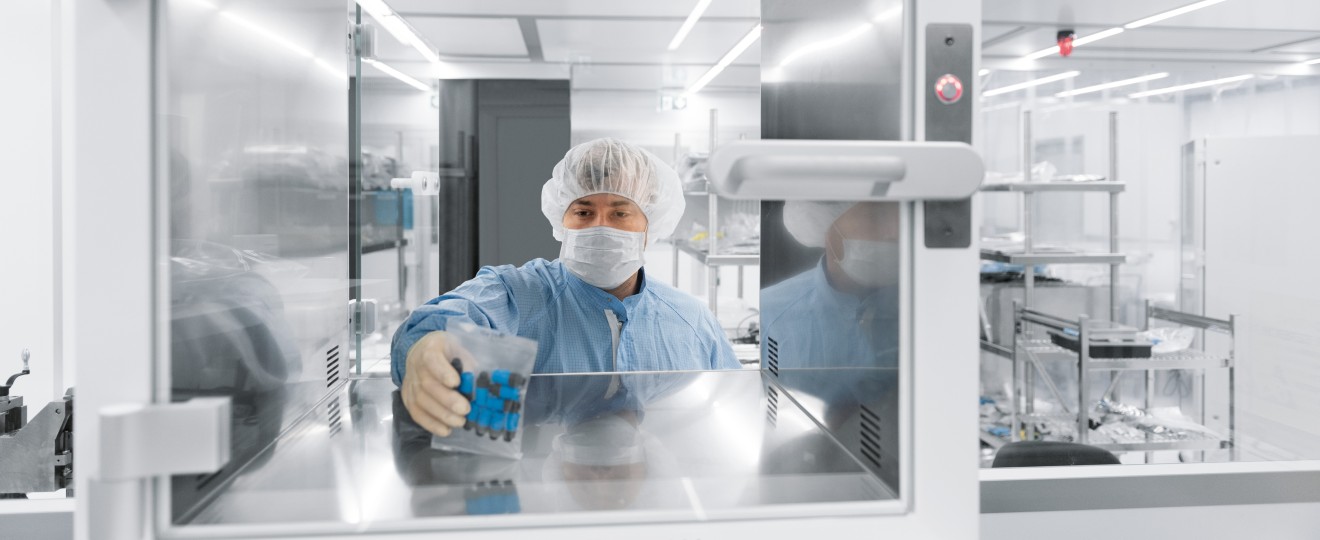Which Festo products are suitable for use in cleanrooms?
You can use all cylinders, valves, grippers and actuators, all handling, vacuum and compressed air systems, sensors, filters, regulators and fittings from a large number of product ranges from Festo in ISO class 7 cleanroom environments. Most are suitable for use in classes 6 and 5, and many can even be used in class 4 environments. We can also provide customized special solutions.
All our cleanroom products are classified into cleanroom classes in accordance with ISO 14644. Cleanroom suitability depends primarily on the installation position and the operating parameters of the product, which means that expert consulting about the use of our products is very important. If you have any questions about using our products in your application, please contact us.
Valuable knowledge concerning cleanrooms
Are there only std. cleanroom products?
Not at all. We frequently come across applications where standard solutions are inadequate. For example, when the cleanliness requirements are so strict that only a special solution can be used. A simple modification is often enough. It’s best to contact our experts directly in cases like this.
Adapted special solutions
We have more than 30 years of cleanroom experience and our engineers continuously adapt series components in order to make them suitable for use in class 4 or stricter environments in accordance with ISO-14644.
We use a two-stage consultation concept: we listen to you and we approach the problem together. Highly sensitive zones can often be isolated, so that even a component that nominally only achieves ISO 5 or 6 in our tests is sufficient. Our engineers put everything together and submit a solution to you, along with a quote.
How are cleanroom products qualified?

Products are classified based on their particle emissions in accordance with the ISO 14644 standard. The relevant classification is defined in ISO 14644-1. This means that all Festo products suitable for the cleanroom are measured in accordance with the ISO standard and the particle emission is evaluated. Festo uses direct measurement with HPC. This method is more accurate and more meaningful.
How does the test work?
The measurement procedure is focused on those locations where the particle concentration is highest (HPC: highest particle concentration). The advantage of this procedure compared to others is that it provides clear conclusions about the particle emission characteristics of our automation components. This particular procedure, during which a measuring probe is used in the laminar and isokinetic air flow, gives a near-perfect representation of the situation in an actual cleanroom environment. With this method, it is also possible to identify locations that are important for particle emission and to draw the relevant conclusions.
And last but not least: when it comes to cleanroom compatibility at Festo, we always assume that closed, monitored compressed air systems are being used, without leakages and without particles being discharged into the environment by the exhaust air.
How are cleanroom products classified?
Rest assured: cleanroom products from Festo are tested and classified in accordance with ISO 14644-1. This is because we believe it is important to have traceable and repeatable measurements. It is the only way in which we can give you advice for your specific requirements.
Please note: Cleanroom suitability depends primarily on the installation position and the operating parameters of the product, which means that expert consulting about the use of our products is very important. If you have any questions about using our products in your application, please contact us.
How do I find fit cleanroom products?
To ensure that you quickly find at a functioning cleanroom application, we’ve compiled all tested components from a large number of Festo’s product ranges in our cleanroom catalog (PDF) including all types of pneumatic actuators, valves and valve terminals, compressed air preparation and accessories, as well as electric drive technology. This is entirely adequate as a rule.
Cleanroom catalog plus X
If you are interested in a product that we haven’t yet tested for cleanroom compatibility, we’d be happy to test it for you upon request. Our specialists are open to any other questions you might have as well, and are capable, for example, of retrofitting any desired components for ISO class 4.
What’s important for cleanroom products?
The most important criterion is that the utilized products comply with the specified cleanroom class during operation. That’s what counts. At Festo, all cleanroom products are certified in accordance with ISO 14644-14. However, the cleanroom class depends on where the product is used within the application. This sounds complicated but it’s good news.
Cleanroom class according to location of use
The fact that the cleanroom-compatibility of a piece of operating equipment always depends on where it’s used means that you don’t have to ensure stricter cleanliness everywhere. Cleanrooms are not homogenous zones. Perhaps you need a product above the workpiece that achieves ISO class 4 according to ISO 14644-1. However, under the workpiece a product can be used that nominally reaches only ISO class 7. Please feel free to inform yourself about this in our cleanroom catalog (PDF).
This applies to packaging as well. Technically correct cleanroom packaging is possible with Festo, but it’s seldom really necessary and you can often do away with this cost factor. Our experience shows that most components can be assembled and prepared for shipping in a normal environment. Final cleaning takes place directly on-site.
Don’t hesitate to get in touch with us if you have any doubts - for example, if the component needs to fulfill a safety function or if your ambient conditions deviate from the values listed in the data sheet.
